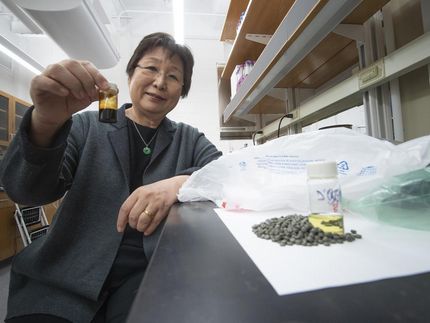'Nanoparticle taxicab' materials can identify, collect and transport debris on surfaces
Inspired by proteins that can recognize dangerous microbes and debris, then engulf such material to get rid of it, polymer scientists led by Todd Emrick at the University of Massachusetts Amherst have developed new polymer-stabilized droplet carriers that can identify and encapsulate nanoparticles for transport in a cell, a kind of "pick up and drop off" service that represents the first successful translation of this biological process in a materials context.

Oil-in-water droplets represented by shiny spheres stabilized by functional surfactants first pick up the nanoparticles, represented by small red balls, when traversing a nanoparticle-coated surface. Later in the same in-line process, when the particle-attached droplets meet the downstream empty surface with a high affinity for the nanoparticles, they drop the nanoparticles off onto the surface and move forward in the aqueous flow.
UMass Amherst/Richard Bai
As Emrick explains, "These carriers act as nanoparticle taxicabs. They find particles on one surface, recognize their composition, pick them up and drop them off later on another surface. The work is inspired by the very sophisticated biological/biochemical machinery operating in vivo, found for example in the case of osteoclasts and osteoblasts that work to balance bone density through deposition and depletion of material. We replicated this with much simpler components: oil, water and polyolefins."
He and colleagues believe theirs is the first demonstration of surface-to-surface nanoparticle transport or relocation, and suggest that "developing these methods would be exceptionally useful as a noninvasive technique for transferring nanoparticle properties (chemical, optical, magnetic or electronic) from one material to another."
The process is different than conventional cleaning,and nanoparticle encapsulation and release processes "represent a potential route to efficient materials transport and/or recycling processes," they add.
The authors say that "designing materials that mimic the complex function of biology holds promise for translating the efficiency and specificity of cellular processes into simple, smart synthetic systems." Future applications might include promoting cell adhesion, which is necessary for maintaining multi-cellular structures, and drug delivery, for example.
Emrick says he and his UMass Amherst co-authors including Richard Bai, George Chang and Al Crosby sought to adapt such biologically inspired advances in two areas: polymer-stabilized emulsion droplets that pick up nanoparticles by engulfing them into the droplet's fluid, and droplets that can deposit nanoparticles onto damaged regions of substrates for repair functions.
Their experimental system used hydroxyapatite, a calcium phosphate-rich structure that resembles the principal composition of bone. They assessed pick-up efficiency in several experimental conditions and attempted to establish the versatility of nanoparticle pick up using a variety of inorganic and plastic substrates. The researchers found that pick up was poor from certain surfaces, suggesting that "substrate composition may be exploited to adjust the relative extent of nanoparticle pick up."
Emrick points out that the project, supported by the U.S. Department of Energy's Office of Basic Energy Sciences, also reflects an "atom efficient" method for materials cleaning and repair. Because of its inherent simplicity and conservation of material, atom efficiency is an important concept in the "green chemistry" approach to producing products.
Original publication
Other news from the department science
These products might interest you

NANOPHOX CS by Sympatec
Particle size analysis in the nano range: Analyzing high concentrations with ease
Reliable results without time-consuming sample preparation

Eclipse by Wyatt Technology
FFF-MALS system for separation and characterization of macromolecules and nanoparticles
The latest and most innovative FFF system designed for highest usability, robustness and data quality

DynaPro Plate Reader III by Wyatt Technology
Screening of biopharmaceuticals and proteins with high-throughput dynamic light scattering (DLS)
Efficiently characterize your sample quality and stability from lead discovery to quality control

Get the chemical industry in your inbox
By submitting this form you agree that LUMITOS AG will send you the newsletter(s) selected above by email. Your data will not be passed on to third parties. Your data will be stored and processed in accordance with our data protection regulations. LUMITOS may contact you by email for the purpose of advertising or market and opinion surveys. You can revoke your consent at any time without giving reasons to LUMITOS AG, Ernst-Augustin-Str. 2, 12489 Berlin, Germany or by e-mail at revoke@lumitos.com with effect for the future. In addition, each email contains a link to unsubscribe from the corresponding newsletter.





























































